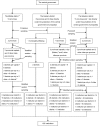The training contents, problems and needs of doctors in urban community health service institutions in China
- PMID: 30486771
- PMCID: PMC6263560
- DOI: 10.1186/s12875-018-0867-6
The training contents, problems and needs of doctors in urban community health service institutions in China
Abstract
Background: The Chinese government offered various types of training programs for strengthening the role of doctors working in community health service institutions (CHSIs). The study intended to investigate the current training programs and training needs of doctors nationally in urban CHSIs in China, and to provide propositions for training more qualified doctors in the future.
Methods: Total 3098 doctors in 192 urban CHSIs were chosen from 9 provinces (Hebei, Liaoning, Shandong, Zhejiang, Fujian, Hunan, Guangxi, Guizhou, Ningxia) and one municipality (Beijing) among 31 provinces in eastern, central, and western regions by stratified sampling methods in Mainland China. All doctors in the selected CHSIs were investigated in this study. We discharged 3073 questionnaires, and the response rate was 98.0%. Descriptive statistics were used to describe the characteristics, training contents, problems and needs of doctors. Differences in training contents, problems and needs between eastern, central and western regions were analyzed with chi-square tests.
Results: 49.3% of doctors in CHSIs had Bachelor's degree and beyond. 12.9% of doctors had senior professional titles. The most frequent training topics for the doctors in eastern, central and western regions were "basic clinical theory knowledge" (52.4%), "community health service competency" (59.6%), "clinical practice skills" (45.9%) respectively. The most serious problem for doctors was "insufficient training time" in eastern (36.8%), central (36.5%) and western (39.6%). The biggest knowledge need for doctors both in eastern (79.8%) and central region (79.1%) was "the updated international medical knowledge", in western region it was "the updated domestic medical knowledge" (73.2%). The biggest skill-related training need for doctors in eastern region (84.1%) and central region (82.6%) was "communication skills", and "diagnosis and differential diagnosis" in western region (78.2%).
Conclusion: Government should design proper training contents according to the knowledge and skill needs of different design. Furthermore, a uniform, rigorous training and evaluation system focus on practicability should be established to promote community health service system in Mainland China.
Keywords: Doctors; Training needs; Training programs; Urban community health care service institutions.
Conflict of interest statement
Ethics approval and consent to participate
It was approved by the Ethical Committee of Capital Medical University, Beijing, China. Data were obtained from a 2011 cross-sectional survey, the Nationwide Investigation on Health Professionals of Community Health Service Institutions in Urban China. Written informed consent was obtained from each participant involved in this study.
Consent for publication
Not applicable.
Competing interests
The authors declare that they have no competing interests.
Publisher’s Note
Springer Nature remains neutral with regard to jurisdictional claims in published maps and institutional affiliations.
Figures



Similar articles
-
Does exam-targeted training help village doctors pass the certified (assistant) physician exam and improve their practical skills? A cross-sectional analysis of village doctors' perspectives in Changzhou in Eastern China.BMC Med Educ. 2018 May 11;18(1):107. doi: 10.1186/s12909-018-1211-5. BMC Med Educ. 2018. PMID: 29751800 Free PMC article.
-
Health workforce equity in urban community health service of China.PLoS One. 2014 Dec 31;9(12):e115988. doi: 10.1371/journal.pone.0115988. eCollection 2014. PLoS One. 2014. PMID: 25551449 Free PMC article.
-
Preferences for training needs of village doctors in China: a systematic review.Fam Pract. 2024 Dec 2;41(6):874-882. doi: 10.1093/fampra/cmad063. Fam Pract. 2024. PMID: 37300310
-
Transformation of health care in China.N Engl J Med. 1984 Apr 5;310(14):932-6. doi: 10.1056/nejm198404053101428. N Engl J Med. 1984. PMID: 6700690
-
An analysis of the current educational status and future training needs of China's rural doctors in 2011.Postgrad Med J. 2013 Apr;89(1050):202-8. doi: 10.1136/postgradmedj-2012-131094. Epub 2013 Feb 6. Postgrad Med J. 2013. PMID: 23389284 Review.
Cited by
-
Current situation and needs analysis of medical staff first aid ability in China: a cross-sectional study.BMC Emerg Med. 2023 Nov 3;23(1):128. doi: 10.1186/s12873-023-00891-x. BMC Emerg Med. 2023. PMID: 37919639 Free PMC article.
-
Facilitators and barriers to implement the family doctor contracting services in China: findings from a qualitative study.BMJ Open. 2019 Oct 8;9(10):e032444. doi: 10.1136/bmjopen-2019-032444. BMJ Open. 2019. PMID: 31597653 Free PMC article.
-
Sociodemographic characteristics, occupational characteristics, motivational factors, and job satisfaction among primary health service practitioners.BMC Prim Care. 2025 Feb 1;26(1):24. doi: 10.1186/s12875-025-02714-3. BMC Prim Care. 2025. PMID: 39893409 Free PMC article.
-
Development of a competency model for general practitioners after standardized residency training in China by a modified Delphi method.BMC Fam Pract. 2021 Aug 26;22(1):171. doi: 10.1186/s12875-021-01508-7. BMC Fam Pract. 2021. PMID: 34433420 Free PMC article.
-
Developing a professional competency framework for general practitioners in tertiary hospitals in China: a modified Delphi study.BMJ Open. 2025 Mar 4;15(3):e082736. doi: 10.1136/bmjopen-2023-082736. BMJ Open. 2025. PMID: 40037672 Free PMC article.
References
-
- National Health and Family Planning Commission of the People’s Republic of China. China health statistical yearbook 2013 [in Chinese]; 2013. Available from: http://www.nhfpc.gov.cn/htmlfiles/zwgkzt/ptjnj/year2013/index2013.html. Accessed 26 Apr 2014.
-
- National Health and Family Planning Commission of the People’s Republic of China [Internet] The notice of medicine and health care medium-term and long-term talents development plan (2011–2020) issued by Ministry of Health [in Chinese] 2011.
Publication types
MeSH terms
LinkOut - more resources
Full Text Sources

